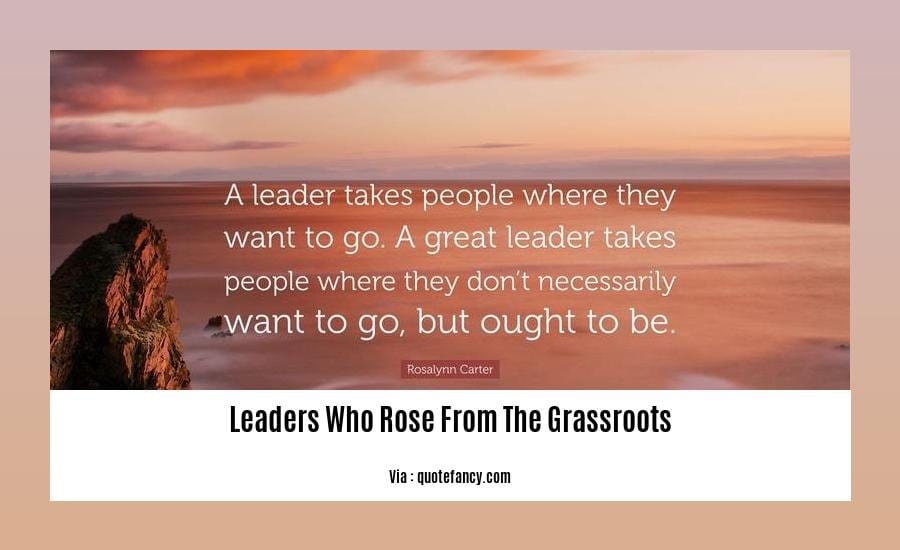In the tapestry of leadership, there are those who ascend from the grassroots, their journeys a testament to resilience, grit, and unwavering determination. Their stories are a beacon of inspiration, illuminating the pathways to leadership success for aspiring leaders and providing valuable lessons for those seeking to foster a culture of inclusive leadership. In this article, “Leaders Who Rose from the Grassroots: Pathways to Leadership Success,” we explore the unique challenges and opportunities faced by these leaders, drawing from real-world examples and expert insights to inspire and empower your own leadership journey.
Key Takeaways:

- Grassroots leaders empower communities to address local issues and advocate for change.
- They often face challenges like lack of resources, access, and resistance from established power structures.
- Their strategies include community organizing, advocacy, direct action, and capacity building.
- Examples of successful grassroots leaders include Editar Ochieng, Elena Crasmari, Amina Mirsakiyeva, Rebecca Chepkateke, and Belen Perugachi.
- Resources are available to support grassroots leaders, such as The Forge and Grassroots Leadership.
Leaders Who Rose from the Grassroots
Grassroots leadership is a powerful force for change. It’s about ordinary people standing up, using collective action to address local issues and advocate for social justice. These leaders play a crucial role in building strong, resilient communities.
Unlike traditional leaders who ascend through established power structures, leaders who rose from the grassroots emerge from the community they serve. They’re in touch with the needs and aspirations of the people they represent. This deep connection gives them a unique perspective and drives their commitment to change.
Challenges Faced by Grassroots Leaders
Grassroots leaders often face significant challenges:
- Limited resources: Grassroots organizations typically operate with limited funding and resources, making it difficult to carry out their work effectively.
- Resistance from established power structures: Grassroots leaders often challenge the status quo, which can lead to resistance from those in power.
- Burnout: The work of a grassroots leader can be demanding and emotionally draining, leading to burnout.
Strategies for Success
Despite these challenges, leaders who rose from the grassroots have developed strategies to achieve their goals:
- Community organizing: This involves mobilizing people around common issues, building relationships, and developing strategies for change.
- Advocacy: Grassroots leaders advocate for policies and changes that benefit their communities. They work to influence decision-makers and raise awareness about important issues.
- Direct action: This involves nonviolent actions such as protests, demonstrations, and civil disobedience to bring attention to issues and demand change.
- Capacity building: Grassroots leaders work to build the skills and knowledge of community members, empowering them to take an active role in addressing issues that affect them.
Examples of Grassroots Leaders
- Van Jones: A CNN commentator and social justice advocate who founded the Dream Corps, which focuses on criminal justice reform and economic empowerment.
- Dolores Huerta: A labor leader and civil rights activist who co-founded the United Farm Workers, which fought for the rights of farmworkers.
- Malala Yousafzai: A Pakistani activist for female education who was shot by the Taliban for speaking out about girls’ right to education.
- Greta Thunberg: A Swedish climate activist who founded the Fridays for Future movement, which organizes school strikes to demand action on climate change.
- Ai-jen Poo: A progressive activist and organizer who co-founded the National Domestic Workers Alliance, which advocates for the rights of domestic workers.
Conclusion
Leaders who rose from the grassroots are an inspiration to us all. They show us that ordinary people can make a difference in the world. By organizing, advocating, and taking direct action, they’re building a more just and equitable society.
Throughout history, there have been numerous political leaders who rose from humble beginnings, demonstrating the power of determination and resilience. Some of these individuals, despite facing significant challenges, went on to achieve remarkable success, becoming influential figures in their respective political landscapes. Others, grassroots political leaders, emerged from local communities to make a meaningful impact on a larger scale. Furthermore, many political leaders have overcome adversity and achieved great things despite having modest upbringings, proving that socioeconomic status does not have to define one’s potential.
The power of vision and purpose: Grassroots leaders with a clear vision can inspire and motivate others to work towards a shared goal.
Grassroots leaders emerge from the lower levels of an organization and engage in networking, organizing, and developing consciousness. These leaders often have a clear vision and purpose that drives their work.
Here are some key takeaways:
- Grassroots leaders are often driven by a desire to make a difference in their communities.
- They are able to connect with people on a personal level and build relationships that are based on trust.
- They are able to inspire and motivate others to work towards a shared goal.
- They are able to adapt to change and overcome challenges.
- They are able to build sustainable organizations that make a lasting impact.
Critical theories, including critical feminist theory and critical race theory, provide a lens for examining grassroots leadership that represents a significant departure from the past. These theories focus on the experiences of marginalized communities and the ways in which power and oppression shape leadership.
Citation:
Grassroots Leadership Models: A Conceptual History
Mentorship and Support: Building a Foundation for Success
Key Takeaways:
- Mentorship provides guidance and support for leaders, helping them navigate challenges and develop essential skills.
- Identifying the right mentor is vital for a successful mentorship experience.
- Creating a supportive work environment fosters open communication and encourages continuous learning.
- Mentorship is a mutually beneficial relationship, benefiting both mentors and mentees.
- Effective mentors prioritize engaging conversations and encourage self-reflection.
How Mentorship Contributes to Leadership Growth
Mentorship plays an instrumental role in the development of effective leaders. Effective mentorships foster growth for both individuals involved. An experienced mentor can provide guidance, support, and a model of leadership for their mentee.
Qualities of an Ideal Mentor
Selecting the right mentor is crucial. An ideal mentor is someone who prioritizes engaging conversations over providing quick answers. They actively listen, ask thoughtful questions, and encourage their mentee to reflect on their experiences and develop their own insights.
Creating a Supportive Environment
Creating a supportive environment is essential for successful leadership development. This includes encouraging open communication, providing access to resources, and promoting a culture of continuous learning and development.
Benefits of Mentorship
Mentorship benefits mentors as well as mentees. Mentors experience increased endorphins and a sense of purpose, while mentees gain valuable knowledge, skills, and networks.
Source
Leadership from the Ground Up: Inspiring Stories of Grassroots Leaders
Grassroots leaders emerge from the communities they represent, understanding their needs and aspirations. These individuals possess exceptional resilience and determination, overcoming challenges such as limited resources, opposition, and burnout to drive meaningful change.
Their strategies often include community organizing, advocacy, direct action, and capacity building, empowering others to participate in decision-making and create lasting impact.
Grassroots Women Leaders:
These trailblazers have broken barriers and inspired countless others.
- Editar Ochieng (Kenya): Founded Feminist for Peace Rights and Justice to combat violence against women and girls.
- Elena Crasmari (Moldova): As the only woman in her local council, she improved access to medical services in her village.
- Amina Mirsakiyeva (Kazakhstan): Pioneered women’s roles in science, becoming a researcher and role model.
- Rebecca Chepkateke (Uganda): Advocates for women’s rights, holding authorities accountable and promoting education and healthcare for girls.
- Belen Perugachi (Ecuador): A teenage councilwoman and indigenous rights advocate representing marginalized communities.
Key Takeaways:
- Grassroots leaders represent the voices of their communities, driving change from the ground up.
- They face challenges, but their resilience and determination empower them to create lasting impact.
- Community organizing, advocacy, and capacity building are key strategies they employ to achieve their goals.
Citation:
UN Women: Grassroots Women Leaders Create Change Across Africa

FAQ
Q1: What are the common challenges faced by grassroots leaders?
Q2: How do grassroots leaders overcome the obstacles they encounter?
Q3: What strategies do grassroots leaders use to mobilize and empower communities?
Q4: Can you provide some inspiring examples of grassroots leaders who have made a significant impact?
Q5: What resources are available to support grassroots leaders in their work?
- Unlock Water’s Symbolism: A Cross-Cultural Exploration - April 20, 2025
- Identify Black and White Snakes: Venomous or Harmless? - April 20, 2025
- Unlocking Potential: Origins High School’s NYC Story - April 20, 2025















